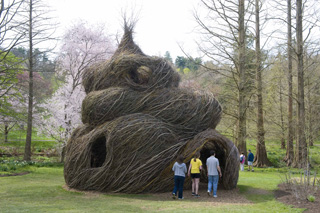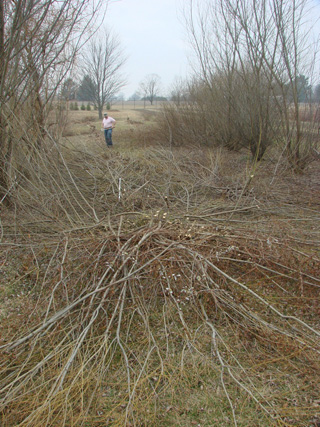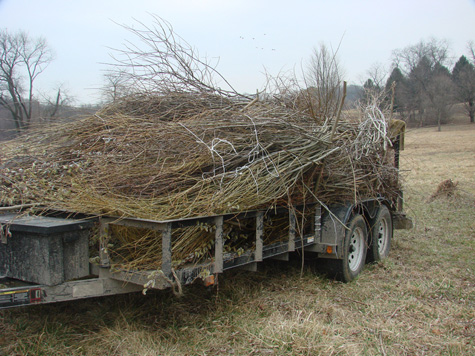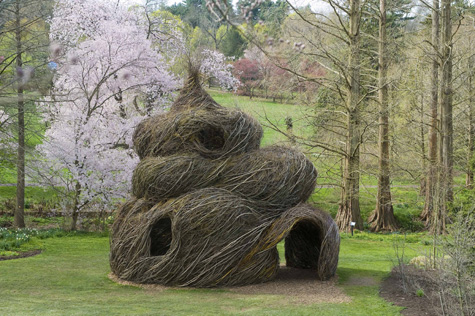Human Flower Project
Hunter-Gatherer-Sculptor
Out of the Pennsylvania wild comes a palace of sticks, the collaboration of a nurseryman and a sculptor. BYOF (bring your own fantasy).

Visitors marvel at Patrick Dougherty’s “Summer Palace,” installed at the Morris Arboretum, Philadelphia, April 2009
Photo: Rob Cardillo, for the Morris Arboretum
By Allen Bush
Gardeners on the fringe are dirt dervishes who sometimes push the gate wide, wide open. They see the forest and the trees.
Bill Barnes, a self-styled nurseryman, has got his thick, calloused fingers in more pies than most. If research scientists are looking for germplasm of red mulberry, Morus rubra, chances are he will know where to find a peculiar phenotype. If special care and expertise are needed to move a huge balled and burlapped Acer wyuense – a very rare maple (try Googling this!)—from Washington’s National Arboretum to the The Morris Arboretum of the University of Pennsylvania, Barnes will be on horticultural speed dial. Who else would dream of breeding the eastern North American prickly pear cactus to western species?
Bill and I talk every few weeks, and in mid-March I called and asked how he was doing. The boundless Jack-of-all horticultural trades, and owner of Lorax Farms, who lives in Warrington, Pennsylvania, near Philadelphia, confessed he was dog-tired from collecting brush all week. The 2005 recipient of the Award of Merit from the Eastern Region of the International Plant Propagators Society (he is also their current president) is way beyond the daily grind of a yard boy. So I asked what’s with the brush? He said he’d gotten a contract from The Morris Arboretum. This brush pile—no ordinary one—was for artist Patrick Dougherty who limbs-up gardens like no other.
 Expert plantsman Bill Barnes of Warrington, Pennsylvania, cut choice branches and felled small trees for the Morris Arboretum in Philadelphia, March 2009.
Expert plantsman Bill Barnes of Warrington, Pennsylvania, cut choice branches and felled small trees for the Morris Arboretum in Philadelphia, March 2009.
Photo: Courtesy of Bill Barnes
Dougherty, of Chapel Hill, North Carolina, had been hired to build a sculpted thicket with Barnes’s brush. The sculptor’s compositions have appeared – and disappeared – around the world since 1986. Installations take, on average, three weeks to construct, withering away in three to four years. I first saw his impressive woven sticks in 1991 at the World Gallery, now closed, in Asheville, NC. And his work popped-up again in 1996 at Spalding University in Louisville. These two beautiful temporary art pieces looked like parabolic amoebas and giant eels – playful, fun and magnificently crafted – the work of an artist whose laboratory training ground was and is the outdoors. As a child, Dougherty spent endless hours wandering, dreaming and making things of sticks.
He was going to need a lot of them for The Morris and knew what would work—and what wouldn’t. Willows, maples (red and sugar), white oak, wild black cherry, weeping hornbeam, and Zelkova were all good; privet, hawthorn and apple were too spiny. The order went out for five trailer loads of brush along with 100 small nursery-grown trees that had trunks 2”-3” thick. Don’t think for a second that you could comb the Yellow Pages and find a commercial landscape crew to come-up with a pile like this. The folks at the Morris knew just whom to call….
Bill Barnes. He got on the horn and enlisted an arborist friend plus two crew novices – a part-time mechanic and an accountant. A week later, Dougherty had his brush pile.

Art supplies: One of five carefully selected wagonloads of willow, maple, and
more that Bill Barnes and his crew gathered for Doughtery’s sculpture.
Photo: Bill Barnes
Work began work on March 30th. At the outset, the sculptor had imagined constructing a snail shell, but the project evolved, taking many twists and turns.
At the end of the first week Barnes said, “This thing looked like a dome on a Russian Orthodox church.” Spring weather the next week didn’t lend a hand. When I checked-in, Barnes reported, “Two-thirds of brush pile was assimilated. But it would rain two days, with three days off; then it rains again.” Barnes told me that Dougherty remained on task, “in the pouring rain, covered in mud from head to toe, headed toward an April 16th reception.” The piece started taking on the look of a different shrine, Barnes said: “This week it looked like the dome of the Taj Mahal’s with an inside maze.” Dougherty was assisted by students, docents, interns, artists, board members, and an architect over the course of the project, but he preferred to work with small groups of three or four at time to keep things manageable.

From a snail to “Summer Palace”—Patrick Dougherty’s sculpture at the Morris Arboretum
Photo: Rob Cardillo, for the Morris Arboretum
On the day of the reception, Barnes left home at 6:30 in the morning to drive to Lancaster County, an hour and a half away, to field dig a large Kentucky coffee tree, Japanese Cryptomeria, boxwoods and assorted trees and shrubs for another client. “The weather has been kickin’ our ass for days,” he complained. There was nothing he could do about it, but with precious few remaining days of dormancy left, he was pressed to pop these plants out of the ground and get them to a new garden before they leafed-out. Barnes was grateful for ice blue skies and a cold wind from the north – perfect digging conditions. After a long day, he loaded two tractor trailer loads of dug trees; it was 9:00 in the evening before he got home. He missed the reception, but it was spring—a time for gardeners to make hay; and he had a living to make that winter ill affords.
 April 2009—A young visitor enters the palace. Dougherty’s sculptures are made NOT to last. They usually “wither away” in three to four years.
April 2009—A young visitor enters the palace. Dougherty’s sculptures are made NOT to last. They usually “wither away” in three to four years.
Photo: Rob Cardillo, for the Morris Arboretum
Pleased by the positive response, Dougherty described the reception as, “totally overwhelming.” He knew the public could be the harshest critic, and he hoped the anointed “Summer Palace”—the name, finally arrived upon, inspired from Dr Zhivago—would be “fanciful and inviting but wouldn’t trap visitors and leave them scratching their heads too much.” The original idea of the snail had, at one point, beckoned the naming of the piece “escargot.” But Dougherty knew someone would eventually ask, “Where are the antennae?” (During construction, visitors also wondered whether he might be building a layer cake.)
Dougherty knows that sticks bristled with meaning for hunters and gathers. He holds a deep conviction that urbanization has diminished access to outdoor areas that can so easily provoke imagination and creativity. In the wild, or in sculpture, sticks prod a fantasy life. “They are lines with which to draw,” he says, “concocting a surface that has vitality. Whatever you can do with pencils, you can do with sticks.”
Comments
I had the distinct pleasure to help out with Patrick’s installation here in Ithaca a couple years ago. It was a real high point for me. You’ll not meet a more gracious artist, a real pleasure to work with. Some pix here: http://www.remarc.com/craig/?p=20
I really enjoy arboreal art installations. I would say that Dougherty’s “Summer Palace” falls at one end of an arboreal art gradient, of which Andy Goldsworthy’s work is at the other end (ex: his wood domes displayed in Madrid – http://www.localecology.org/images/madrid_wooddome_goldsworthy_3.jpg).
What’s in the middle? One piece is “Starseeds” by landscape architect Carl Smith. Star Seeds was installed on the campus on the Univ. of Arkansas this year. See the work here – http://carriewhittle.com/?p=63


Way hey! Now that’s what I’d call a “twigloo”